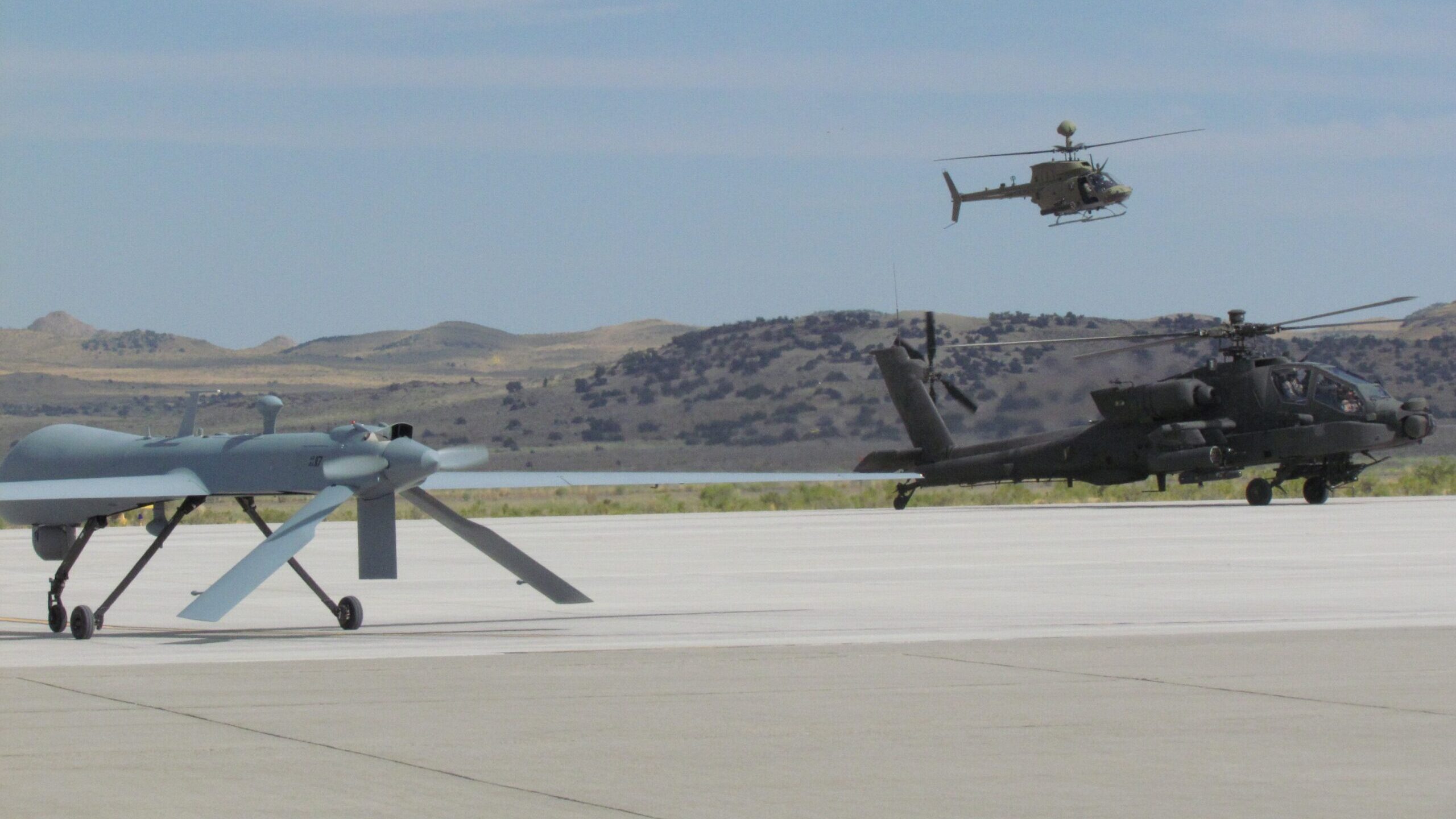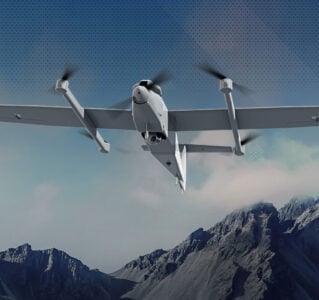
A rare 2011 photo showing the US Army variant of the Predator drone, the MQ-1C Grey Eagle (left); the AH-64 Apache attack helicopter (right); and the since-retired OH-58D Kiowa Warrior scout helicopter (in flight). (US Army photo)
WASHINGTON — Some of the US Army’s highest-tech units require a lot of old-fashioned human labor, a problem the service wants to fix.
“It’s kind of a paradox that our ‘unmanned’ formations are larger than our manned formations,’” said Maj. Gen. Michael McCurry, a veteran helicopter pilot who now heads the Army aviation “schoolhouse” at Fort Rucker, Ala. “We have Apache [attack helicopter] companies that are just over 30 people and we have Grey Eagle [drone] companies that are 135 people [or more]. How do we make better use of the 135 people in ‘unmanned’ formations?”
The issue isn’t just efficient use of human resources — although with Army recruiting 25 percent short of its target for 2022, and the combat-hardened veterans of Iraq and Afghanistan increasingly eligible for retirement, a personnel shortfall is a major problem for America’s largest service. But it’s also a tactical imperative, because big units make big targets — not just more people and more vehicles, but more radio emissions for the enemy to track, more fuel supplies that have to be moved forward by yet more vehicles, and more cargo aircraft to deploy. Notably, official Army doctrine for large-scale, high-tech warfare emphasizes fast-moving “multi-domain operations” by small, dispersed formations.
RELATED: Three questions following the Army’s FLRAA decision
So the service is striving to streamline its “unmanned” formations, McCurry and other Army aviation leaders explained last week at an Association of the US Army Hot Topic mini-conference on aviation. Both the large, long-ranged Grey Eagle (a variant of the famous Predator) and many smaller, shorter-ranged drones require runways to take off and land. They are remote-controlled by operators sitting at static ground stations, typically two humans per drone. And they require even more humans to maintain them and to analyze the hours of sensor data they collect.
Part of the answer is hardware: new, nimbler drones that can take off and land vertically, without a runway or extensive support equipment on the ground, like the new Future Tactical Unmanned Aerial System, McCurry said.
Part of the solution is software. FTUAS will also be use a new “scalable control interface” that lets soldiers operate the drone while they’re on the move, McCurry said. The Army is also exploring artificial intelligence to help smaller numbers of humans make sense of the “massive amount of data coming at you” from an ever-larger array of sensors.
But algorithms and unmanned aircraft can’t meet every mission, McCurry emphasized. A recent analysis by the federally funded thinktank MITRE of 123 tasks an air cavalry squadron has to perform, he said, found that “today we can’t do that autonomously — probably not in 2040 either.”
So it’s vital to work on human-machine teaming — organic brains and algorithms working together. That’s something the service has struggled with in the past, for example when it mixed manned helicopters and drones in recon units but didn’t always issue the necessary communications links or provide adequate time for training amidst constant rotations to Afghanistan and, earlier, Iraq.
“Did we give enough time to the commanders to train with that equipment?” said Maj. Gen. William Taylor, director of the aviation section on the Army’s Pentagon headquarters staff. “What we found was, quite honestly, no.”

AeroVironment’s JUMP 20 drone, selected for the Army FTUAS program (AeroVironment photo)
In fall 2021, however, with the start of the 2022 fiscal year, the Army switched from its counterinsurgency-era rotation schedule to a new cycle known as REARMM. This Regionally Aligned Readiness & Modernization Model sets aside more time for both upgrading a unit’s equipment and training its people on the new tech.
The synch-up between equipment and training is still far from perfect, Taylor acknowledged. “There is never a time where you can just stop and just modernize. Our requirement to continually train pilots, crew chiefs, flight engineers remains,” he said. “Because we have soldiers that have great initiative and have this great desire to learn, they overcome some of our failures at the staff level.”
But that catch-up takes a lot of extra hours and a lot of individual expertise, at a time when many experienced aviators and ground grew are retiring. “What we have seen is a loss of a lot of that experience through retirement,” McCurry said.
At the same time, the Army is asking its aviators to take on more tactically complicated tasks That includes not just operating in conjunction with unmanned aircraft, but also moving in larger formations of manned helicopters than the two- and four-ship sorties typical of counterinsurgency warfare, and against more sophisticated anti-aircraft threats — think Russia or China rather than al-Qaeda — which force pilots to fly low and fast.
While the focus on well-armed nation-states is a return to Cold War-era training in many ways, it’s a very different, much higher-tech world than generals like McCurry grew up in, he said ruefully. “I flew an unarmed OH-58 Charlie in Desert Storm, so there wasn’t a lot of high tech in that cockpit, especially when the aerial observer let the map fly out the door,” he said to laughter.
Today, he said, “we look at machine learning, the advance of artificial intelligence — how do we offload crews, how can I take that young warrant officer sitting in the front seat of the AH-64 with all of this data coming at him and help him? What tasks can we offload from that crewmember to make him a more efficient fighter on the battlefield?”
Navy jet trainer fleet operations remain paused after engine mishap
One week after the incident, a Navy spokesperson says the service is continuing to assess the fleet’s ability to safely resume flight.


























